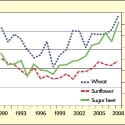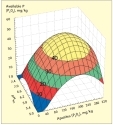12 Dec 2013
The Efficiency of Potassium Fertilizer Use in Western Siberia
By Vladimir N. Yakimenko and Vladimir V. Nosov
Recent statistics highlight widespread nutrient depletion within the extensive farming systems of the Siberian Federal District of Russia. Agricultural enterprises only applied about 7 kg N, 2 kg P2O5 and less than 1 kg K2O per hectare of sown area in 2011 (ROSSTAT, 2012). Farm-ers widely rely on a fallow year to gather plant-available N reserves, which is generated from nitrate (NO3-N) accumula-tion through soil OM mineralization. However, this does have negative implications for soil OM reserves and their ability to maintain nutrient supplying power year after year. Crops also rely heavily on a continuous tapping of any available soil P and K reserve. Considering the need to intensify crop production in the Western-Siberian region, while recognizing the regional economic realities, the issues related to the most effective and eff cient use of mineral fertilizers, including K fertilizers, seem very important.
Critical Field Trials
Nowadays, there are practically no f eld experiments in Western Siberia studying the use of K fertilizer. However, our brief review summarizes results ob-tained from the most recent critical re-search conducted in the region (Table 1). The highest K response in spring wheat was found on soddy-podzolic soils (Umbric Albeluvisol) because these soils have low plant-available K. The relative grain yield increase due to K ranged between 6 to 28%. The effect of K fertilizer on crop yield was much higher on coarse-textured soddy-podzolic soils, which have the lowest level of plant-available K. Ap-plication of K on grey forest soils and dark grey forest soils (Humic Luvisol) increased spring wheat yields by 2 to 11%. On leached chernozems (Luvic Chernozem), K fertilization contrib-uted as much as 16% to grain yields; however, some f eld experiments con-ducted on these soils did not show any advantage to K use in cereal crops. Yield of maize grown for green forage on chernozem soils increased by 8 to 10% due to K application. On cher-nozemic soil, crop response to applied K is highly dependant on the level of plant-available K. Exchangeable K content in chernozems of Western Si-beria can be very high at 600 ppm K2O and above and a response to applied K is unlikely under such conditions, especially in cereal crops.
Long-term studies conducted on grey forest soils revealed that exchangeable K is a better indi-cator of soil K status compared to routinely measured available K (extracted with acetic acid [CH3COOH] solution). Exchange-able K better ref ects soil K depletion, and also build up, of soil fertility resulting from any K application (Yakimenko, 2009). In addition to the improved soil test interpretation classes for routinely measured available K in the forest-steppe zone; soil test interpretation classes for exchangeable K were also developed in consideration of soil textural classes (Table 2).
It is important to note that the majority of fertilizer experi-ments above have been short-term f eld trials with spring wheat and vegetable crop rotations (3 to 4 years) without long-term omission of K and hence without considerable soil K deple-tion. Moreover, crop yield levels were low in many of these experiments resulting in relatively low quantities of nutrients required for crop growth and development. Earlier reviews of fertilizer experiments conducted in forest and forest-steppe zones of Western Siberia indicate that K fertilizer use becomes necessary only when the yield level of cereal crops is higher than 3 t/ha (Gamzikov et al., 1989). A single season f eld experiment with spring wheat conducted in Omsk Oblast in 2011 on a leached chernozem with very high exchangeable K came to the same conclusion (unpublished IPNI data). There is a relative lack of regional experimental data on the eff ciency of K fertilizer within high K demanding crops.
Cropping System Studies
Field experiments conducted from 1988 to 2005 help to answer many important questions regarding the eff ciency of K fertilizer use in common cropping systems of Western Siberia. On previously uncultivated grey forest soil with medium loam texture at the surface, an initial exchangeable K level of 145 ppm K2O, OM content of 4.9%, and CEC of 21 cmol/kg soil (Yakimenko, 2006), f eld experiments were simultaneously conducted in two experimental areas with different cropping patterns: 1) cereals and fodder crops, and 2) vegetables and potato. Three cycles of the following crop rotation were run at the f rst experimental area: spring wheat–spring wheat–spring barley–oat/pea (green forage mixture). Spring wheat was then cultivated during two years and maize for silage was grown in the subsequent years. Three cycles of crop rotation with vegetables and potato were similarly run at the second ex-perimental area: white cabbage–tomato–onion–carrot. Then, potato was grown in monoculture till the end of experiment. Field experiments included the following treatments: 1) zero fertilizer (control); 2) NP; 3) NPK1; 4) NPK2; 5) NPK3; 6) NPK4. Rates of N and P fertilizers were calculated based on a 100% replenishment of nutrient removal in high yielding crops and four levels of K were applied to replenish K removal by 25, 50, 75, and 100%, respectively. Fertilizer rates for each crop grown under two cropping systems are given in Table 3. Fertilizers were applied in spring before sowing or planting of seedlings as ammonium nitrate, triple superphosphate, and potassium chloride (KCl).
The long-term average yield data for the ‘cereals-fodder crops’ system reveal a trend towards higher yields within the 1st spring wheat and spring barley crops as a result of K fertilization (Table 4). A signif cant yield response in the 2nd wheat crop was obtained when the highest K rate was applied (90 kg K2O/ha). The highest K rates (108 and 225 kg K2O/ha) also resulted in a signif cant increase in green forage yield of both the oat-pea forage mixture and maize.
The experimental data obtained under the ‘vegetable-potato’ system found a signif cant yield increase for these high K demanding crops (potato, carrot) even under the lowest K application rates (64 and 81 kg K2O/ha). Signif cant yield increases in cabbage, tomato and onion were only obtained with the highest K rates, but practically all K rates provided evidence towards higher vegetable crop yields with their use. The highest yield response to K fertilizer was found in potato. Potato tuber yield increased by 1.8 to 2.4 times as a result of K applied at the four rates studied. Forage maize was the second most K responsive crop as green forage yield was improved by 1.4 times under the highest K rate of 225 kg K2O/ha. Carrot also responded well to fertilizer K. Yield of carrot roots was increased by 1.3 times at the highest K rate of 256 kg K2O/ha.The lowest rates of K fertilizer applied under the ‘cereals-fodder crops’ system (30 to 75 kg K2O/ha) gave agronomic eff ciencies for K (AEK) values of 4.0, 3.7 and 5.9 kg grain/kg K2O in 1st spring wheat, 2nd spring wheat and spring barley, respectively. Similarly, values for AEK in the oat-pea mixture and maize were 28 and 144 kg green forage/kg K2O. Respective AEK values under the ‘vegetable-potato’ system at the lowest rates of K input (25 to 111 kg K2O/ha) were 42, 100, 80, 175, and 141 kg production/kg K2O in cabbage, tomato, onion, carrot, and potato. The inclusion of K certainly generated the most prof table return when applied to most K demanding crops such as vegetables, potato and forage maize because these crops provided the highest yield increase. It is more interesting to assess the current prof tability of K input to ce-real crops because of the large area involved. We estimate that K fertil-izer use in spring wheat (3rd grade soft wheat: gluten 23 to 28%) and spring barley (fodder grain) could be prof table in 2012 with a AEK higher than 2.4 to 2.5 kg grain/kg K2O excluding the costs of fertilizer delivery to the farm, fertilizer ap-plication and additional harvesting and drying for the added grain yield. Our estimates indicate that K fertil-izer use in cereal crops grown on grey forest soils of Western Siberia is quite prof table and the maximum economic response can be achieved in barley as compared to wheat.
Conclusions
When growers make decisions on K application it is necessary to consider the level of soil exchange-able K, expected crop yield, and hence the crop’s need for additional K. Fertilizer distribution in Western Siberia is not yet well developed and regional farm gate prices for wheat may be not as attractive for growers because of existing logistical prob-lems. Thus it is quite possible that value-to-cost ratios for K fertilizer use in wheat would be unfavorable. In such cases, it is reasonable to apply K to the most K demanding crops within the crop rotation and take advantage of any residual K during the spring wheat cropping season.
Dr. Yakimenko is a Leading Scientist at the Laboratory of Agrochem-istry, Institute of Soil Science and Agrochemistry, Siberian Branch of Russian Academy of Sciences, Novosibirsk; e-mail: yakimenko@issa.nsc.ru.
Dr. Nosov is Director, IPNI Southern and Eastern Russia Region, Moscow; e-mail: vnosov@ipni.net.
References
Gamzikov, G.P., V.B. Ilyin, V.M. Nazaryuk et al. 1989. Agrochemical parameters of soils and efficiency of fertilizers. Nauka, Siberian Branch, Novosibirsk. 254 p. (In Russian).
ROSSTAT. 2012. http://www.gks.ru
Yakimenko, V.N. 2003. Potassium in soils of Western Siberia agrocoenoses: PostDoc Dissertation. Novosibirsk. 306 p. (In Russian).
Yakimenko, V.N. 2006. Agrochemistry, 5: 3-11. (In Russian).
Yakimenko, V.N. 2009. Soil Fertility, 4 (49): 8-10. (In Russian).




